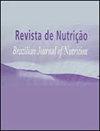基于生态框架的Seferihisar地区高二学生营养习惯评价
IF 0.6
4区 医学
Q4 NUTRITION & DIETETICS
Revista De Nutricao-brazilian Journal of Nutrition
Pub Date : 2021-07-02
DOI:10.1590/1678-9865202134e200089
引用次数: 0
摘要
【摘要】目的基于生态框架,研究土耳其Seferihisar市高中二年级学生的营养习惯及其相关因素。方法采用自填问卷的横断面研究方法,采用青少年饮食习惯检查表对392名公立学校高中二年级学生的营养习惯进行测量。基于Mary Story的生态框架(个体因素、社会因素、自然因素和宏观环境),计算饮食习惯得分并对相关因素进行4层评价。通过多层次线性回归分析这些层与饮食习惯评分之间的关系。结果学生参与率为87.7% (n=344)。在所有层面(从个人因素到社会环境和宏观环境的影响:营养素养、同龄人在学校的食品消费、家中是否有水果蔬菜、是否在学校食堂购买垃圾食品、学校是否有海报等)中,基于线性回归分析,对广告食品的选择有统计学解释(p<0.05)。从生态框架衍生出的模型解释了45%的营养习惯,其中四个层次的贡献相当。学生们居住的地方有健康食品,营养素养水平较高,形成了健康的营养习惯。在学校食堂以可承受的价格出售健康食品,使用海报宣传健康饮食,并在课程中引入与营养有关的课程,将有助于学生养成健康的营养习惯。本文章由计算机程序翻译,如有差异,请以英文原文为准。
Evaluation of the nutritional habits of second-year high school students in the Seferihisar region with the ecological framework
ABSTRACT Objective The study aims to identify the nutritional habits of second-year high school students in Seferihisar, Turkey, and the factors associated thereof, based on the Ecological Framework. Methods In this cross-sectional study by a self-reported questionnaire, second-year high school students (n=392) attending public schools in Seferihisar had their nutritional habits measured with the Adolescent Food Habits Checklist scale. The food habit score was calculated and associated factors were evaluated in 4 layers based on the Mary Story’s Ecological Framework (individual factors, social, physical and macro-level environments). The data analysis for the association of these layers with the food habits score was executed through multi-level linear regression. Results Students’ participation rate was 87.7% (n=344). Of all the layers (from individual factors to the influence of the social environment and macro-level environment: nutritional literacy, the food consumption of their peers at school, availability of fruits-vegetables at home, buying junk food at the school canteen, presence of posters at school, etc.), the option for advertised food items was statistically explanatory based on the linear regression analysis (p<0.05). Conclusions The model derived from the Ecological Framework explained 45% of the nutritional habits with an equivalent contribution from the four layers. Availability of healthy food items where the students lived and higher levels of nutritional literacy led to healthy nutritional habits. Having healthy food items sold at school canteens at affordable prices, using posters to promote a healthy diet, and introducing nutrition-related courses into the curricula would support students in developing healthy nutritional habits.
求助全文
通过发布文献求助,成功后即可免费获取论文全文。
去求助
来源期刊
CiteScore
1.20
自引率
12.50%
发文量
24
审稿时长
6-12 weeks
期刊介绍:
Revista de Nutrição is former Revista de Nutrição da Puccamp, founded in 1988. It is a bimonthly publication every four months and it is of responsibility of the Centro de Ciências da Vida, da Pontifícia Universidade Católica de Campinas . It publishes articles that contribute to the study of Nutrition in its many sub-areas and interfaces; and is open to contributions of the national and international scientific communities.

 求助内容:
求助内容: 应助结果提醒方式:
应助结果提醒方式:


